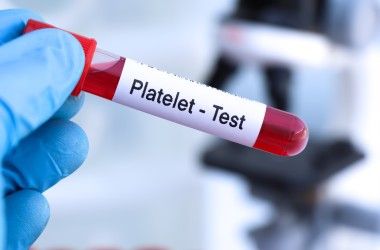General Health
Platelet Count – Normal Range, Purpose, Procedure, And Results Interpretation
6 min read
By Apollo 24|7, Published on - 21 May 2025
Share this article
0
0 like

Platelets, also known as thrombocytes, are small, disc-shaped cells in your blood that play a crucial role in clotting and wound healing. When you sustain an injury, platelets gather at the site, forming a plug to prevent excessive bleeding. The platelet count test, also called a thrombocyte count, measures the number of platelets in your blood and helps assess clotting function.
A normal platelet count is essential for maintaining balance- both too few and too many platelets can lead to health complications. Conditions such as excessive bleeding, blood clots, or disorders like thrombocytopenia (low platelet count) and thrombocytosis (high platelet count) can significantly impact overall health. This test is often ordered as part of a routine complete blood count (CBC) or to investigate symptoms like unexplained bruising or prolonged bleeding.
Purpose of the Platelet Count Test
The platelet count test serves several important diagnostic and monitoring purposes:
- Diagnosing Bleeding Disorders: A low platelet count may indicate conditions such as immune thrombocytopenia (ITP), aplastic anaemia, or bone marrow disorders, which can impair the blood's ability to clot properly.
- Monitoring Chronic Diseases: This test helps manage chronic conditions like liver disease, kidney disease, or leukaemia, as these often affect platelet levels.
- Evaluating Clotting Disorders: High platelet counts can signal the risk of developing blood clots, associated with conditions like essential thrombocythemia or other myeloproliferative disorders.
- Assessing Bone Marrow Health: Platelet production occurs in the bone marrow, so abnormalities in platelet counts can indicate underlying bone marrow dysfunction or diseases.
- Monitoring Treatment Response: For patients undergoing chemotherapy, radiation therapy, or medications that affect platelet production, the test evaluates how these treatments impact clotting function.
By providing critical insights into clotting and blood health, the platelet count test is indispensable for diagnosing and managing a wide range of medical conditions.
How to Prepare for a Platelet Count Test?
Preparing for a platelet count test is simple. Here’s what you need to know:
- Medication Disclosure: Inform your doctor about any medications or supplements you are taking, such as aspirin, blood thinners, or herbal remedies, as these can affect platelet levels.
- Diet and Fasting: Typically, no fasting is required before a platelet count test. However, if it’s part of a broader set of blood tests, your doctor may provide specific instructions.
- Avoid Vigorous Activity: Strenuous physical activity or stress before the test can temporarily alter platelet levels, so it's best to stay relaxed.
- Health History: Notify your healthcare provider if you’ve recently had an infection, surgery, or a transfusion, as these events can impact your platelet count.
By following these simple steps, you can ensure accurate and reliable test results.
Procedure for Platelet Count Test
The platelet count test is a quick and minimally invasive procedure:
- Blood Sample Collection: A healthcare professional will clean the skin and insert a sterile needle into a vein, typically in your arm, to draw a small blood sample.
Sample Handling: The collected blood is placed in a test tube or vial and sent to the laboratory for analysis. - Laboratory Analysis: Automated machines or manual methods are used to count the number of platelets in a specific volume of blood. In some cases, peripheral blood smears may be examined under a microscope for additional insights.
The procedure typically takes just a few minutes and causes minimal discomfort. Results are often available within 24-48 hours, depending on the lab.
Platelet Count: Results Interpretation
The platelet count test results provide insight into the number of platelets present in a given volume of blood, expressed as platelets per microliter (platelets/µL).
- Normal Platelet Count: A healthy adult typically has 150,000 to 450,000 platelets/µL. This range is sufficient to ensure proper clotting and wound healing.
- Low Platelet Count (Thrombocytopenia): A count below 150,000 platelets/µL may indicate conditions such as bone marrow disorders, immune thrombocytopenia, or side effects of medications like chemotherapy. Symptoms can include excessive bruising, nosebleeds, or prolonged bleeding.
- High Platelet Count (Thrombocytosis): A count above 450,000 platelets/µL may suggest disorders like essential thrombocythemia, chronic inflammation, or irondeficiency. High counts can increase the risk of blood clots, which may lead to complications like stroke or deep vein thrombosis (DVT).
Your healthcare provider will interpret these results alongside your medical history and other tests to determine the underlying cause and appropriate next steps.
Normal Platelet Ranges
The normal range for platelet counts can vary slightly depending on the laboratory and individual factors such as age and overall health:
- Adults: The typical platelet count is between 150,000 and 450,000 platelets/µL of blood.
- Children: Platelet counts are often slightly higher due to their developing bodies.
- Pregnant Women: Counts may decrease slightly due to physiological changes such as increased blood volume, platelet consumption, and aggregation.
Abnormal Platelet Counts
Low Platelet Count (Thrombocytopenia): A count below 150,000 platelets/µL may indicate conditions such as:
- Viral infections (e.g., dengue fever).
- Autoimmune disorders (e.g., lupus).
- Bone marrow disorders or certain cancers.
Side effects of medications.
Severe thrombocytopenia (platelet counts below 50,000/µL) increases the risk of bleeding and requires immediate medical attention.
- High Platelet Count (Thrombocytosis): A count above 450,000 platelets/µL may be associated with:
- Chronic inflammation or infections.
- Certain cancers.
- Iron deficiency.
- Primary thrombocythemia (a bone marrow disorder).
- Persistently high counts may increase the risk of clotting, which can lead to complications such as strokes or heart attacks.
Managing Abnormal Platelet Count Results
Management strategies for abnormal platelet counts depend on the underlying cause:
For Low Platelet Counts (Thrombocytopenia):
- Medications: Steroids or immunoglobulin therapies may be prescribed to suppress an overactive immune response.
- Blood Transfusions: Platelet transfusions can help in severe cases to prevent excessive bleeding.
- Treating the Underlying Cause: Addressing infections, discontinuing problematic medications, or treating bone marrow disorders may help restore normal platelet levels.
For High Platelet Counts (Thrombocytosis):
- Medications: Low-dose aspirin or other drugs may be used to reduce the risk of blood clots.
- Addressing Conditions: Treating the underlying issue, such as iron deficiency or inflammation, often normalises platelet levels.
Lifestyle Modifications:
- Eating a balanced diet and staying hydrated support healthy blood function.
- Avoiding smoking and managing stress may help maintain stable platelet counts.
- Regular follow-ups and blood tests are essential to monitor platelet levels and adjust treatment plans as needed.
Conclusion
The platelet count test is a vital diagnostic tool for evaluating clotting function and overall blood health. It plays a crucial role in diagnosing conditions like bleeding disorders, chronic diseases, and clotting disorders while helping healthcare providers monitor treatment effectiveness.
Understanding what the test measures and interpreting the results enables patients to make informed decisions about their health. Whether the test reveals a low or high platelet count, timely medical intervention and proper management can prevent complications and support overall well-being.
General Health
Frequently Asked Questions
What is the platelet count normal range for male and female
What is the platelet count normal range for male and female
Does the platelet count normal range for female differ from males?
Does the platelet count normal range for female differ from males?
What is considered a low platelet count?
What is considered a low platelet count?
What is considered a high platelet count?
What is considered a high platelet count?
Can platelet levels fluctuate due to temporary factors?
Can platelet levels fluctuate due to temporary factors?
Do platelet ranges differ by age?
Do platelet ranges differ by age?
Are newborn platelet counts different from adults?
Are newborn platelet counts different from adults?
What steps can I take to maintain healthy platelet levels?
What steps can I take to maintain healthy platelet levels?
Why does pregnancy affect platelet counts?
Why does pregnancy affect platelet counts?
Leave Comment
Recommended for you

General Health
Oil Pulling: Know How It Promotes Good Oral Hygiene
Good oral health is essential for overall well-being. And, oil pulling can help achieve this naturally and effectively. Unlike chemical-laden mouthwashes and toothpaste, oil pulling is a natural and safe alternative. It removes harmful bacteria, whitens your teeth and helps you maintain your dental health. Read on to learn the benefits of oil pulling and its usage.
.jpg?tr=q-80)
General Health
Managing Acute Fatty Liver of Pregnancy: Tips for Expectant Mothers
Every mother wants to give birth to a healthy child and ensure her health is at its best. However, certain conditions can make this journey difficult. One such condition is Acute Fatty Liver of Pregnancy (AFLP). AFLP is a severe obstetric emergency that can lead to serious complications for both the mother and the baby, including death. It is characterised by liver dysfunction and failure that occurs during pregnancy.
.jpg?tr=q-80)
General Health
Iron Studies Test: Purpose, Procedure, Range, and Results
Iron Studies Test helps assess iron levels & detect deficiencies. Learn about its purpose, procedure, normal range, and how to interpret test results.
Subscribe
Sign up for our free Health Library Daily Newsletter
Get doctor-approved health tips, news, and more.
Visual Stories

Science-backed Home Remedies for Burns and Blisters
Tap to continue exploring
Recommended for you

General Health
Oil Pulling: Know How It Promotes Good Oral Hygiene
Good oral health is essential for overall well-being. And, oil pulling can help achieve this naturally and effectively. Unlike chemical-laden mouthwashes and toothpaste, oil pulling is a natural and safe alternative. It removes harmful bacteria, whitens your teeth and helps you maintain your dental health. Read on to learn the benefits of oil pulling and its usage.
.jpg?tr=q-80)
General Health
Managing Acute Fatty Liver of Pregnancy: Tips for Expectant Mothers
Every mother wants to give birth to a healthy child and ensure her health is at its best. However, certain conditions can make this journey difficult. One such condition is Acute Fatty Liver of Pregnancy (AFLP). AFLP is a severe obstetric emergency that can lead to serious complications for both the mother and the baby, including death. It is characterised by liver dysfunction and failure that occurs during pregnancy.
.jpg?tr=q-80)
General Health
Iron Studies Test: Purpose, Procedure, Range, and Results
Iron Studies Test helps assess iron levels & detect deficiencies. Learn about its purpose, procedure, normal range, and how to interpret test results.